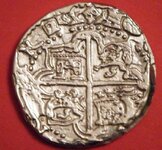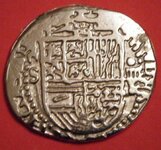ehudson80
Tenderfoot
- Jun 7, 2009
- 8
- 0
- Detector(s) used
- White's DFX * Garrett AT Pro * White's Bullseye II pinpointer * Vibra Probe 580 Waterproof pinpointer
Can anyone tell me how to tell if this is a fake or any information about this. It is about the size of a US half dollar, and I found it this morning while beach hunting on Captiva Island, Florida [barrier island off of Ft. Meyers]. It was only about 3 1/2 down, but Hurricane Charley destroyed the area and they have done a lot of work reconstructing the beaches and a lot of dredging in the area. DVI number of my Whites DFX was 81.
It appears to be an 8 Reale, I've found similar on the internet but with different initials.
What do you think?
It appears to be an 8 Reale, I've found similar on the internet but with different initials.
What do you think?












